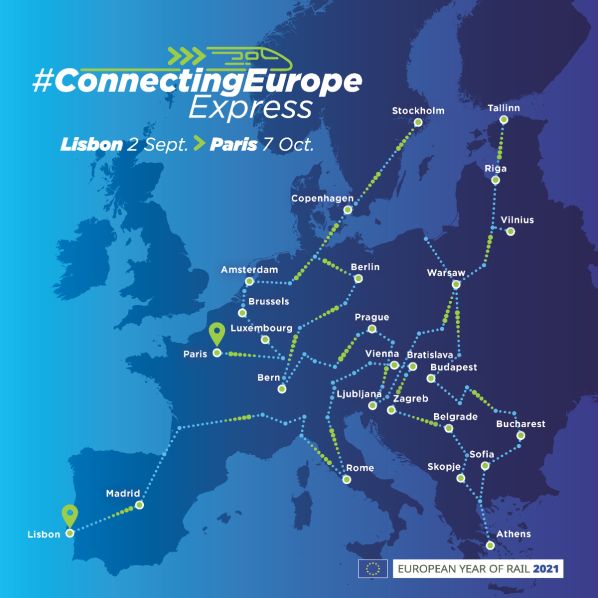TO coincide with Europe Day, the European Commission (EC) announced details of the timetable for the Connecting Europe Express (CEE) on May 9. The train will visit 26 countries in 36 days this autumn to demonstrate the power of rail to connect people and businesses, and the role that European Union (EU) infrastructure policy is playing to make this possible.
The train will commence its approximately 20,000km journey in Lisbon on September 2 and will visit 40 cities in 26 countries, including 24 capitals, crossing 33 borders. The train will conclude its journey in Paris on October 7.
The CEE is a key initiative of the European Year of Rail and involves close collaboration between the EC, the Community of European Railway and Infrastructure Companies (CER), rail operators, infrastructure managers and other partners at the EU and the local level. Events will be held at each of the stops to emphasise the key role that rail plays in society but also the challenges the mode faces to attract more passengers and freight.
Indeed, the CEE itself will comprise three different trains to comply with the 1668mm Iberian, 1435mm and 1520mm gauges in use in Europe. The standard-gauge train will consist of six coaches, two of which will host mobile exhibitions to showcase technologies helping to improve rail, and EU support for infrastructure projects. Conference, sitting, dinning and sleeping coaches will complete the train.
Five conferences have already been confirmed to take place along the route in Lisbon, Bucharest, Brdo, Berlin, and Bettembourg, which will address the plans for rail outlined in the EU’s Sustainable and Smart Mobility Strategy.
“Crisscrossing the continent, from Lisbon to Bucharest and from Berlin to Paris, the CEE will follow routes that bind us together - whether as countries, businesses or people,” says European commissioner for transport, Ms Adina Vălean. “While a symbol for connectivity, this train also serves as a reminder that we still have a long way to go and much work to do before rail becomes the transport option of choice for Europeans.”
When will the train visit my city?

The train’s journey is as follows:
September 3: Lisbon - Madrid
September 4: Madrid - Hendaye - Bordeaux
September 5: Bordeaux - Chambéry - Turin
September 6: Turin - Milan - Genoa
September 7: Genoa - Rome - Verona
September 8: Verona - Bolzano - Brenner - Innsbruck
September 9: Innsbruck - Salzburg - Linz - St Pölten - Vienna
September 10: Vienna - Bratislava - Sopron - Szombathely
September 11: Szombathely - Gyékényes - Zagreb
September 12: Zagreb - Belgrade
September 13: Belgrade - Niš - Skopje
September 14: Skopje - Gevgelia - Idomeni - Thesssaloniki - Athens
September 15: Athens - Thesssaloniki - Kulata - Sofia
September 16: Sofia - Ruse
September 17: Ruse - Bucharest
September 18: Bucharest - Brașov - Sibíu - Oradea - Arad
September 19: Arad - Lőkösháza - Budapest - Košice - Muszyna - Warsaw
September 20: Warsaw - Gdansk
September 21: Gdańsk - Warsaw - Białystok
September 22: Białystok - Trakiszki - Kaunas - Krakow
September 23: Krakow - Ostrava - Břeclav - Graz - Maribor - Ljubljana
September 24: Ljubljana - Celje - Maribor - Graz - Břeclav - Brno
September 25: Brno - Prague
September 26: Prague - Domažlice - Munich
September 27: Munich - Ulm - Stuttgart - Bern
September 28: Bern - Basel - Frankfurt
September 29: Frankfurt - Berlin
September 30: Berlin - Copenhagen
October 1: Copenhagen - Malmö - Lund - Stockholm
October 2: Stockholm - Hamburg
October 3: Hamburg - Bad Bentheim - Amsterdam
October 4: Amsterdam - Rotterdam - Roosendaal - Antwerp - Brussels
October 5: Brussels - Bettembourg
October 6: Bettembourg - Strasbourg, and
October 7: Strasbourg - Paris.
The timetable for a separate 1520mm-gauge Baltic CEE train is:
September 21: Tallinn - Tartu - Valka - Riga - Vilnius
September 22: Vilnius - Kaunas.

